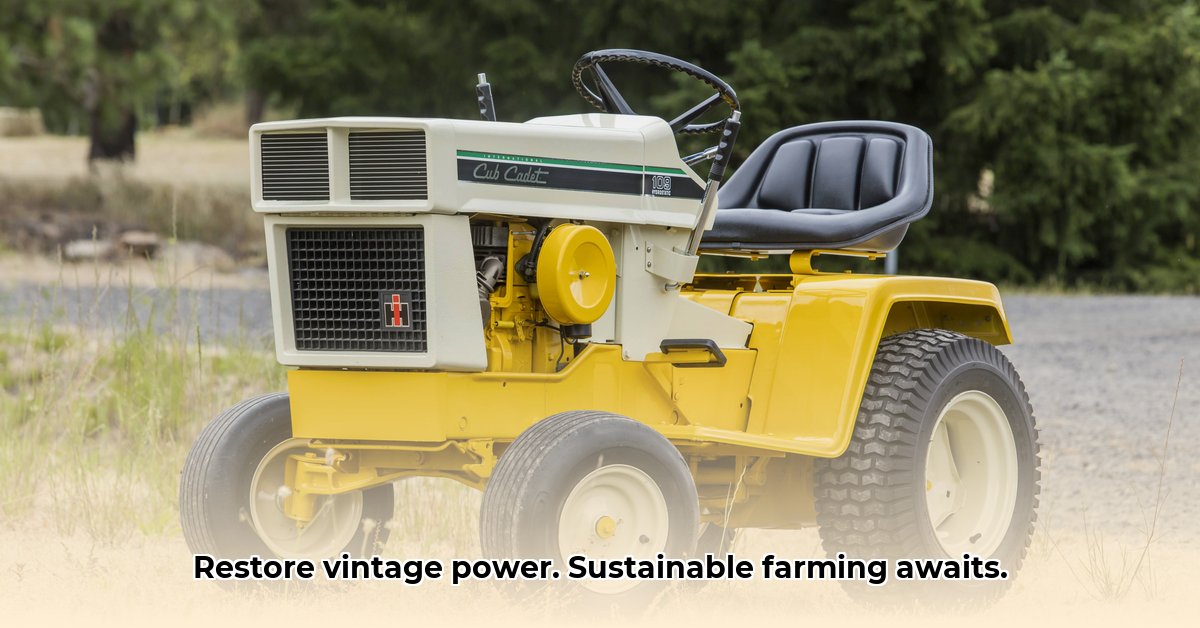
Old Cub Cadet Garden Tractors: A Legacy of Durability and Sustainable Farming
The rhythmic chug of an old Cub Cadet garden tractor evokes a sense of simpler times, hardworking farmers, and a deep connection to the land. But these aren't mere relics of the past; these robust machines hold valuable lessons for sustainable agriculture. Their enduring durability and repairability offer a compelling counterpoint to today's often disposable technology. This article explores the history of Cub Cadet tractors, examining their impact on farming practices and highlighting their potential role in a more sustainable agricultural future. For more on similar durable tractors, check out this resource on Simplicity tractors.
The Golden Age: International Harvester and Built-to-Last Engineering
During the International Harvester era, Cub Cadet tractors were synonymous with quality and resilience. Constructed with thick cast iron, sturdy steel, and straightforward mechanics, these weren't flimsy machines; they were built to endure decades of hard labor. This inherent durability is a key element of sustainability. Why? Because minimizing equipment replacement directly reduces the environmental impact associated with manufacturing new machinery. Fewer new tractors mean fewer resources consumed and less pollution generated. These weren't just tools; they were investments, often passed down through families, demonstrating their lasting value. Isn't it remarkable how a focus on quality translates into environmental responsibility?
Consolidation and Change: The MTD Era and Economies of Scale
The acquisition of Cub Cadet by MTD signaled a significant shift. The emphasis moved towards economies of scale – producing more tractors at a lower cost per unit. This often involved design and material changes, sometimes compromising the longevity of earlier models. Did this shift negatively impact durability? While some later models did witness shorter lifespans, the story is more complex. Mass production made tractors more accessible to a broader range of farmers. However, it also altered the lifecycle of the machines, often requiring more frequent replacements. The long-term environmental implications of this transition remain a topic of ongoing study and debate.
Sustainability Implications: A Lifecycle Analysis
What is the true environmental footprint of an old Cub Cadet? It’s a multifaceted issue. Manufacturing, transportation, and ultimately disposing of the tractors all leave an imprint on the environment. Although older models often boast superior longevity, their fuel efficiency may not match modern standards. However, the ease of repair and maintenance significantly counterbalances this drawback. A well-maintained older machine frequently requires fewer resources over its lifetime than constantly replacing newer, less durable models. Ongoing research continues to refine our understanding of the complete lifecycle environmental impact of agricultural equipment.
Sustainable Farming: Blending Old and New
The Cub Cadet story reflects a broader trend in agriculture. While consolidation and specialization have increased efficiency, they’ve also impacted smaller farmers and local food systems. How can we balance large-scale efficiency with sustainable practices and local food production? The answer likely lies in a thoughtful integration of traditional approaches with modern innovations. We can learn from the past, embracing the principles of robust construction and repairability while adapting these values to future designs.
Actionable Steps: A Collaborative Approach to Sustainability
Here’s how various stakeholders can contribute to a more sustainable agricultural future, inspired by the Cub Cadet's legacy:
Sustainable Farmers: Prioritize repairs over replacements; source parts locally; consider collaborative repair shops. Long-term, invest in durable, repairable equipment; explore alternative power sources (e.g., electric or hybrid); advocate for supportive policies.
MTD/Cub Cadet: Increase parts availability for older models; support repair/restoration; provide enhanced training for mechanics. Long-term, commit to sustainable manufacturing processes; create initiatives for recycling and responsible disposal.
Policy Makers: Fund research on the lifecycle impacts of farm equipment; support repair and maintenance programs; incentivize sustainable equipment. Long-term, encourage the development of robust, repairable machinery; implement policies supporting sustainable agriculture and local food systems.
Researchers: Conduct thorough research on the lifecycle environmental impact of agricultural machinery; investigate new, energy-efficient technologies; and develop accessible, open-source repair manuals and training programs.
The Enduring Legacy: Rethinking Our Relationship with Technology
The story of the old Cub Cadet transcends the machine itself. It's about our relationship with technology and its environmental impact. By learning from the past, we can make informed choices for the future, creating an agricultural system that is both productive and environmentally responsible. The steady hum of that classic engine serves as a potent reminder of past wisdom, offering invaluable lessons for the challenges we face today. The future of sustainable agriculture may indeed benefit from the durable lessons of these vintage machines.